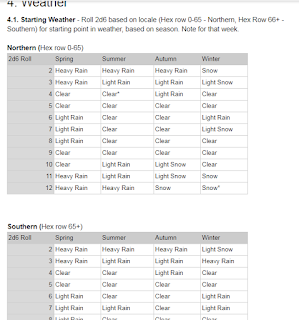Campaign movement at wargame and D&D scales
Gary Gygax famously wrote that Dungeon Masters must keep careful track of time in their campaign, for ensuring that player resources were being used, for tracking for wandering monsters/encounters, and for determining player movement.
One of the things that some wargame referees/players will do is include the effects of weather into their campaigns and games. It makes a difference - ask the French or German armies about attacking Russia during rainy/snow seasons.
Now put the two together...
I track the weather as carefully as I track time in my campaign world. I don't (as yet) have some sort of climate model, that is far too much work and brainpower for me to engage in (right now). What I do have is a weather chart for the northern and southern climes of my campaign world, inspired by the books “The Solo Wargaming Guide” by William Silvester and “Ancient Wargaming, Setting Up a Wargames Campaign” by Tony Bath.
The questions for me have been:
I've adopted Tony Bath's approach for road types: Class 1 roads (think good Roman roads), Class 2 roads (dirt roads) and Country/Overland (which include trails and non-maintained roads. When there's precipitation, the Class 2 and overland roads are affected. Eventually, they dry out. But how do I consistently track that?
I had used Tony's method for precipitation affecting movement, but it felt clunky and didn't feel consistent. As a result, I adopted this approach - at the wargame/hex level:
So how do I translate the effects down to a D&D level?
No effect and impassable are easy - you either can or can't. At the strategic level, I track movement at a week scale, so a -1 for an individual rider or small group doesn't seem to really matter so much. At the -2 level, I might cut down the overland movement rate by about a quarter. That would indicate that the country or dirt roads are starting to get rough.
For missile fire or other things affected by precipitation at a D&D scale, if the week is a heavy rain/snow weather period, I roll a d6. If it's a 1, then the weather is not happening bad enough to affect the action. Otherwise, missile fire is lessened to short range only.
I should also note that I don't go for uber-realistic - more about consistency and the effect.
One of the things that some wargame referees/players will do is include the effects of weather into their campaigns and games. It makes a difference - ask the French or German armies about attacking Russia during rainy/snow seasons.
Now put the two together...
I track the weather as carefully as I track time in my campaign world. I don't (as yet) have some sort of climate model, that is far too much work and brainpower for me to engage in (right now). What I do have is a weather chart for the northern and southern climes of my campaign world, inspired by the books “The Solo Wargaming Guide” by William Silvester and “Ancient Wargaming, Setting Up a Wargames Campaign” by Tony Bath.
The questions for me have been:
- How do I account for rain/snow in a consistent manner?
- How do I translate the effects of weather at a wargame/strategic level down to the movement rates and effects at a 1-to-1 D&D level?
I've adopted Tony Bath's approach for road types: Class 1 roads (think good Roman roads), Class 2 roads (dirt roads) and Country/Overland (which include trails and non-maintained roads. When there's precipitation, the Class 2 and overland roads are affected. Eventually, they dry out. But how do I consistently track that?
I had used Tony's method for precipitation affecting movement, but it felt clunky and didn't feel consistent. As a result, I adopted this approach - at the wargame/hex level:
4.3 Effects of weather on movement
Turn of Light Rain/Light Snow = +.5 precipitation.
Turn of Heavy Rain/Snow = +1 precipitation
Turn of Clear = -1 precipitation
Precipitation
|
Effect
|
0 - .5
|
No effect
|
1 - 1.5
|
-1 Movement rate on Class 2/Overland
|
2 - 2.5
|
-2 Movement rate on Class 2/Overland
|
3
|
Class 2/Overland impassable. Class 1 bridges may be impassable. (1-2 on 1d6)
|
Precipitation’s effect on weather are calculated at end of turn and applied to next turn.
So how do I translate the effects down to a D&D level?
No effect and impassable are easy - you either can or can't. At the strategic level, I track movement at a week scale, so a -1 for an individual rider or small group doesn't seem to really matter so much. At the -2 level, I might cut down the overland movement rate by about a quarter. That would indicate that the country or dirt roads are starting to get rough.
For missile fire or other things affected by precipitation at a D&D scale, if the week is a heavy rain/snow weather period, I roll a d6. If it's a 1, then the weather is not happening bad enough to affect the action. Otherwise, missile fire is lessened to short range only.
I should also note that I don't go for uber-realistic - more about consistency and the effect.

